How relevant is 80s Armani?
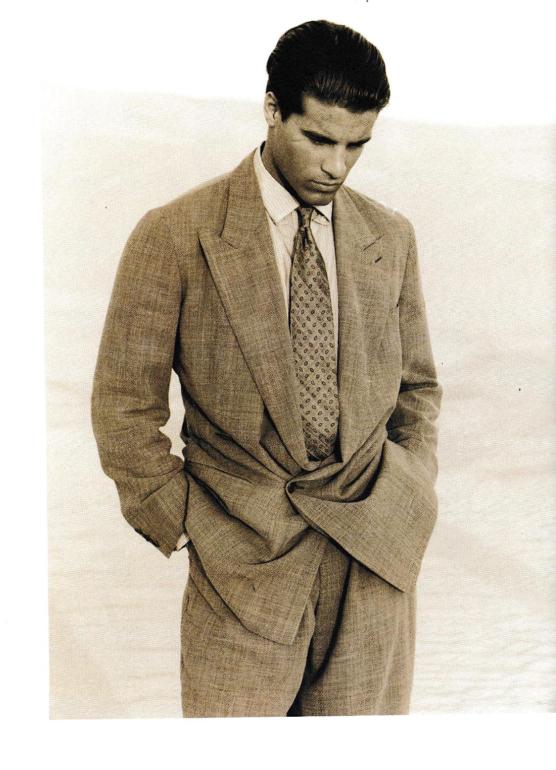
By Tony Sylvester
It might seem counterintuitive to be talking about past fads or subcultures on a platform named Permanent Style. But while it is certainly admirable for a man to build a wardrobe around the timeless and perennial, it would be foolish to suggest that some sense of the ephemeral will not creep in.
This is only natural. An inquisitive mind searches out that which is novel, while anyone with a passing interest in the history and culture of how people have dressed cannot help but be taken by the discovery of some long-lost detail.
To my mind, the key to preserving accord while taking inspiration from the past is to cast a critical eye and to 'pull back', viewing from as wide a point as possible, using the lessons you have learnt of what works for you as a filter.
Every era has its acolytes and naysayers, but perhaps the most maligned decade of 20th Century menswear is the 1980s. The brash arrogance of the Thatcher/Reagan years is ripe for parody and derision, and has not seen quite the same re-evaluation as the luxuriously androgynous spirit of the 1970s (currently in vogue in some tailoring circles).
The 1980s are viewed as a time when a vibrant underground provided the sartorial dynamism, while the mainstream remained irredeemably naff and drab. I would like - in this article - to provide a counter-argument in the form of the pioneering work of Giorgio Armani.
In 1975, Armani launched his eponymous label after a decade working as a freelance designer for fashion brands in Italy. Immediately focusing on luxury, ready-to-wear menswear, his first collection for SS76 - shown at Pitti that year - exhibits an incredible confidence.
The nascent hallmarks of his signature approach are already there: a generously draped silhouette, a muted palette, and a preference for soft inviting textures.
We are fortunate that Rizzoli published a coffee-table sized monograph in 1990 entitled Giorgio Armani: Images Of Man. It chronicles the collections from this all-important decade, and illustrates all three prongs of his attack.
Right from the early looks, we can see how Armani plays with proportion.
A shearling blouson (above) is cut extraordinarily high for a piece of outerwear, sitting and fitting as close to the waistline as the trouser, mere inches below an oversized raglan sleeve.
Overcoats and trenches exhibit similar billowing folds of fabric at the chest, while being dramatically cinched at the waist, suggesting the look of a comic-book strongman.
The presumed formality of a double-breasted suit (above, top) is softened with an extended shoulder line, and a relaxed, baggy cut.
Whole looks are built off single colours, the tight focus making slight contrasts in tone much more dramatic.
The use of pale greys, washed greens and beiges, meanwhile, signals the influence of militaria and field clothing, and contributes to a faded lived-in feel.
Examples of both, extracts from early and late eighties collections respectively, are shown above.
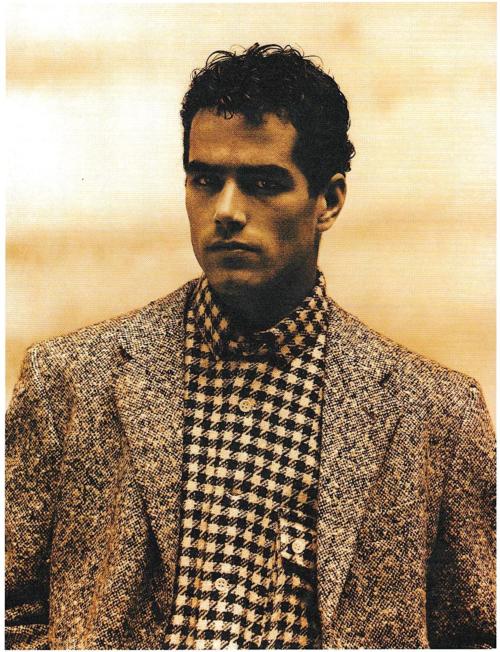
Texture is used to create contrast. A donegal tweed jacket paired with a surprisingly robust-looking shepherd's-check shirt creates unexpected harmony between the pattern sizes (above).
Elsewhere, the heavy stripe of an overcoat lies over the deep diagonal line of a cavalry-twill trouser. And a chunky polo plays off the marl of a covert-cloth sports coat, the whole look rich and tactile, despite being shot in monochrome.
There is much to take from in the collections, and it's astonishing how many of the outfits have resonance today. Bigger proportions have been around for several years among both mainstream and designer brands, and tonal dressing has become a constant theme for both the fashionable and sartorial.
Personally I find the use of pattern particularly striking, as well as the lack of traditional colour combinations.
A navy blazer with Armani will be shot through with a warming grey, while Prince-of-Wales checks are exploded into oversized detail, and sports coats use jacquard-like weaves rather than more commonplace windowpanes.
As the book ably demonstrates, Armani’s work was thrust into its best possible light by his collaboration with photographer and graphic designer Aldo Fellai.
Colleagues from their freelance days, Fellai’s pictures add an immeasurable merit to Armani’s work - casting them in a genuinely revolutionary manner. It opened up the vistas of how clothes would be visually marketed for years to come.
The focus on black and white imagery, astonishing for a clothing brand when you think about it, would become the de facto tool for many trademark campaigns of the nineties. You simply would not have The Gap’s or Calvin Klein’s iconic billboard ads without their innovation.
I can see the throughlines with some modern brands.
Yasuto Kamoshita (above) certainly carries that utility of function in his Camoshita line, along with unexpected combinations of soft, washed colourways.
One of my favourite pieces in the Rizzoli book feels very current: a stunning piece of outerwear in the form of a hybrid of sorts; the classic alpaca ‘teddy bear’ coat crossed with the simplicity of a robe; an extremely generous shawl lapel, ankle length and turnback cuff adding to the visual delight (below).
I was lucky enough to find one in a rich ruddy brown in impeccable condition on eBay a while back, a rare find 20 years after its make. The Outer Gown by London brand Gownsmith has something of the same feel to me, in spirit if not detail.
Perhaps the contemporary label I most closely associate with the pioneering era of Armani is another London-based maker, Scott Fraser Simpson (below).
His Scott Fraser Collection nominally takes its cues from an earlier time - the ‘modernism’ of mid-century style - and yet something of the overall look owes a visual debt to Armani and Fellai.
Catching up with Scott, he concurs. “I think it’s the proportions. The generous armholes and deep drape that allow you to not look or feel pulled in or constricted. It adds that relaxed feel but with a head nod of consideration. It’s always been my plan to bring more of that generosity into the flow of my clothes.”
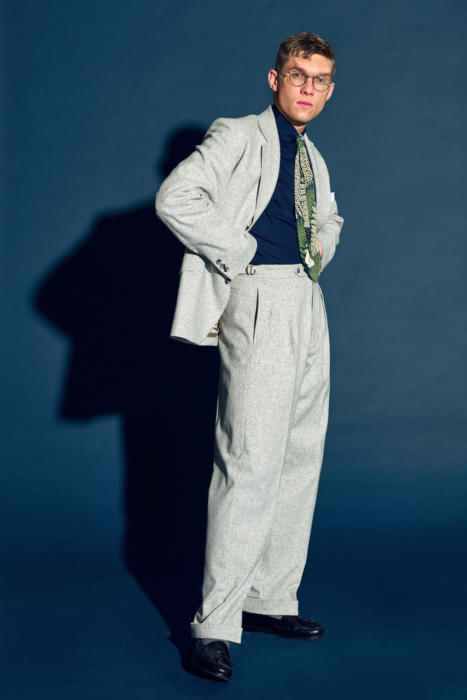
“What I love about this is that clothes can transcend different occasions”, he continues: “when you want to be formal or when you want to be casual. It breaks those boundaries. It is thoughtful without typecasting the wearer.
“The other element is the fabrics. In those Armani collections you got chunky tweed on top of a birdseye check and a pinstripe, all thrown together.
"There’s an unexpected artistry to the blend which has changed the way I look at fabrics and how to put them together. I’m forever searching out old rolls of deadstock fabric and end-of-lines to get that same effect.”
As Harold Koda puts it so eloquently in the introduction to Images Of Man, “Giorgio Armani’s clothing for men from 1975 to 1990...constituted [a] profound inquiry into textile, comfort, the equilibrium between leisure and business”.
Post-Covid, will we not be asking ourselves the very same questions of our wardrobes?
I feel like I already am, thanks in no small part to the imagery here. More restrictively cut garments have been sent to the back of the closet, shirt and knitwear purchases have been sized up, and newer commissions from Fred Nieddu at Taillour have ventured into much more relaxed territory (above).
Shoulders have extended a little, sleeves are wider with more room in the chest. Trousers have deeper pleats, there’s less taper from the knee and cuffs are rounding out at 9.5 or 10 inches.


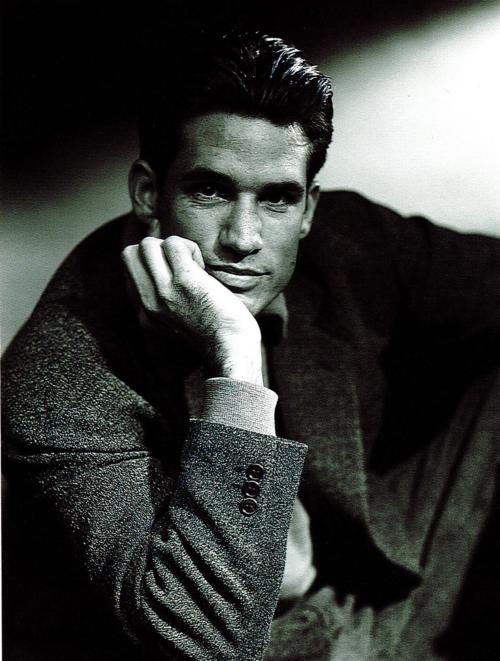
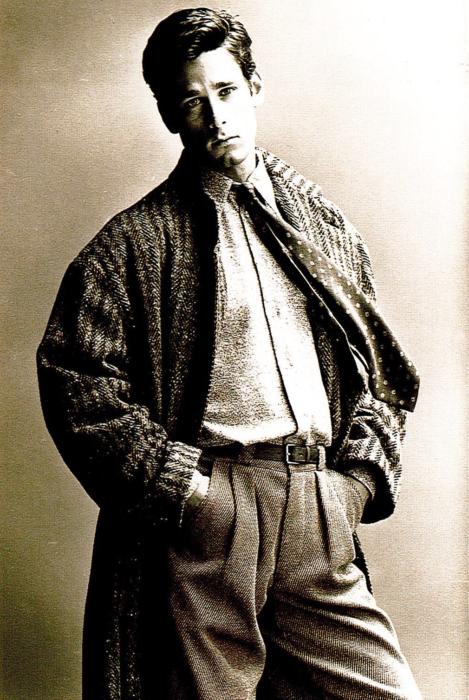
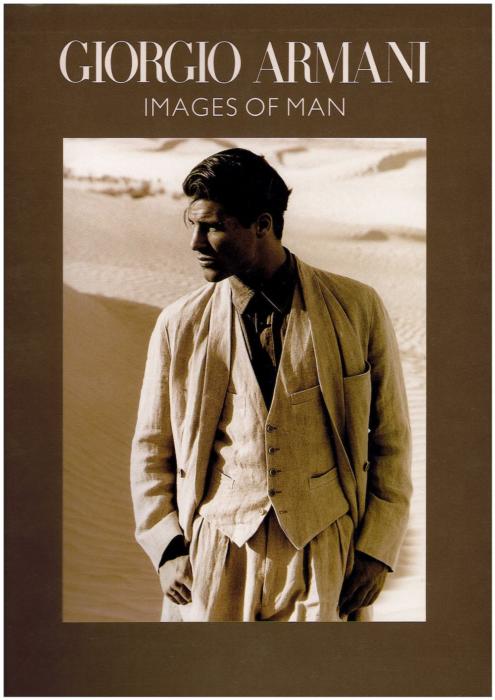
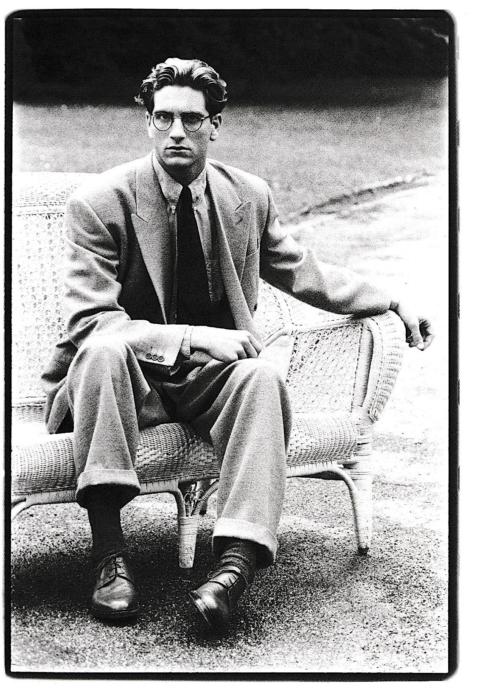
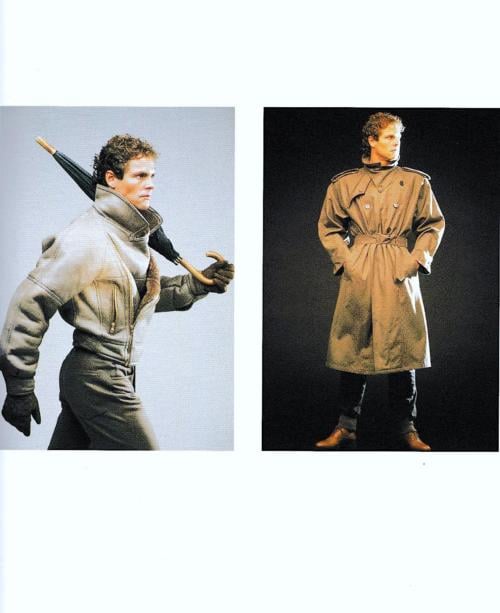
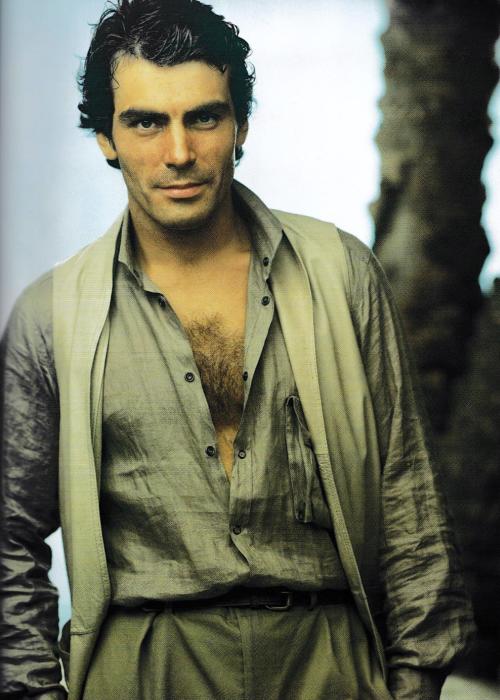
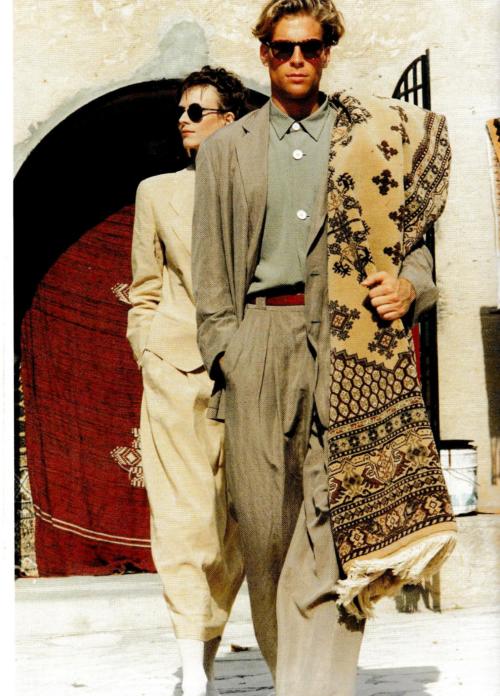
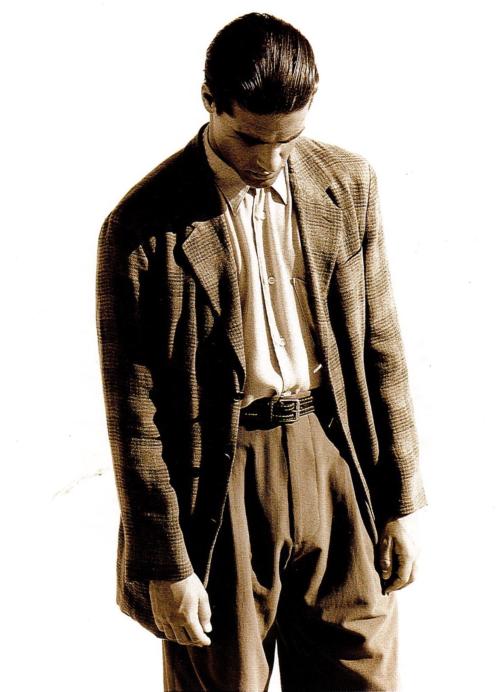
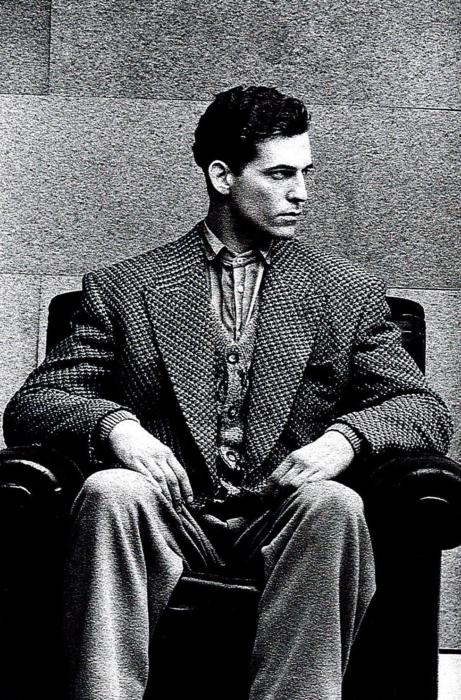
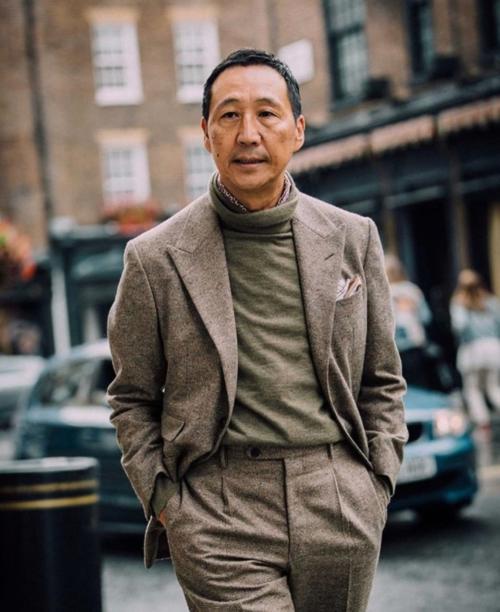
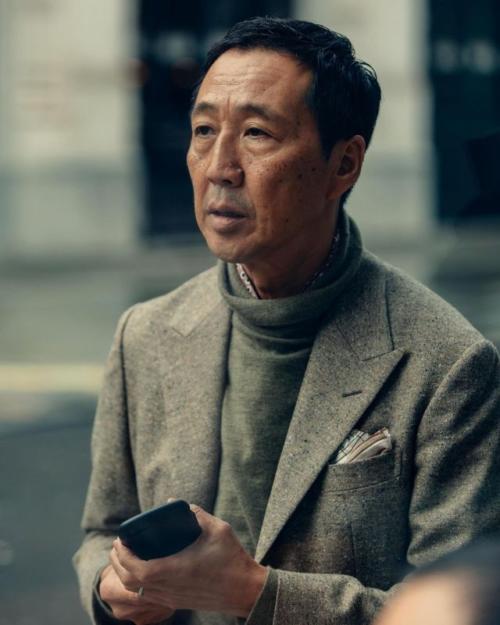
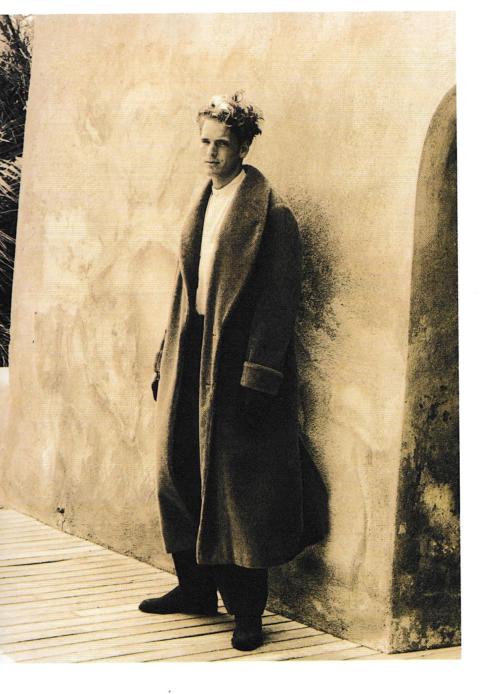
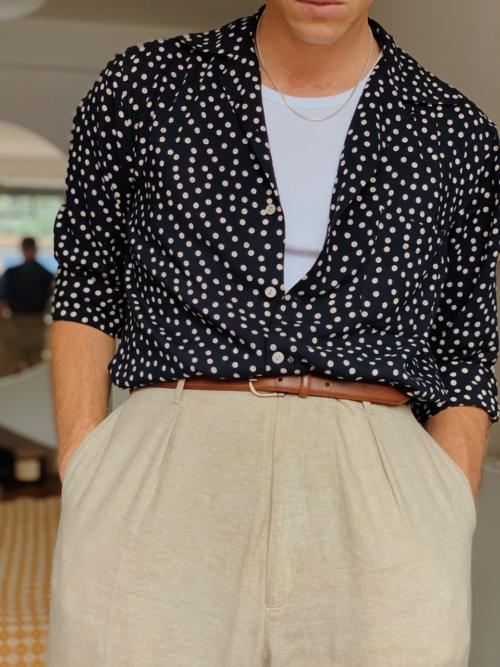
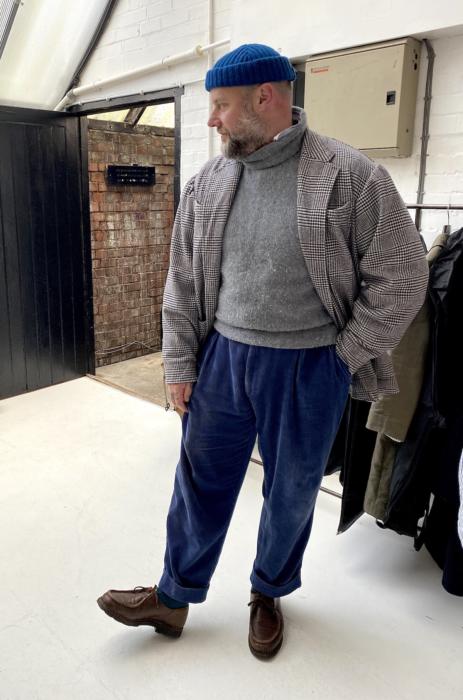
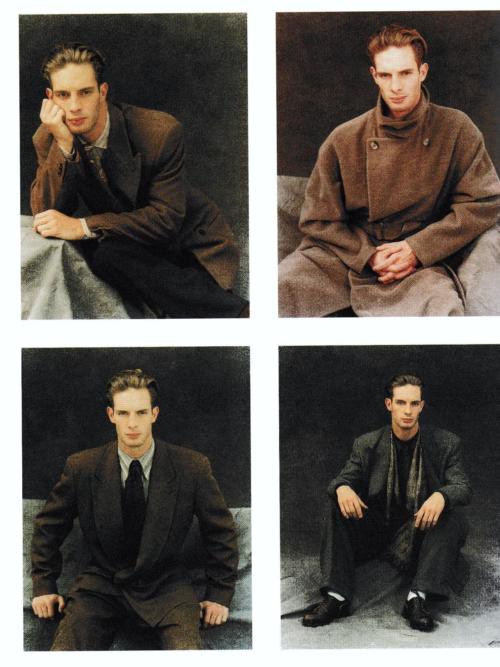
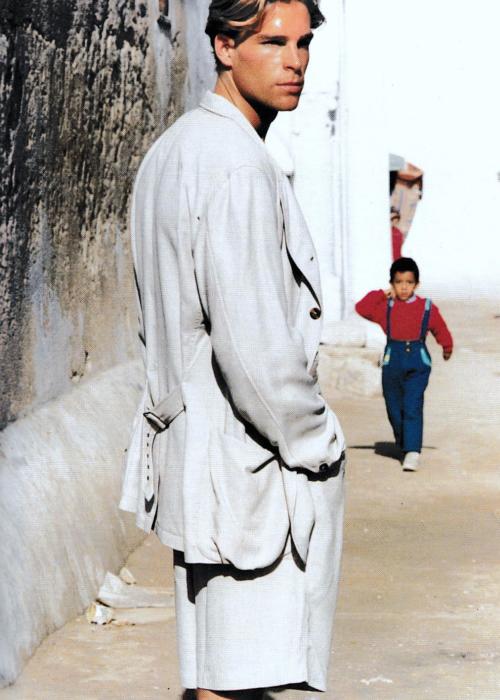
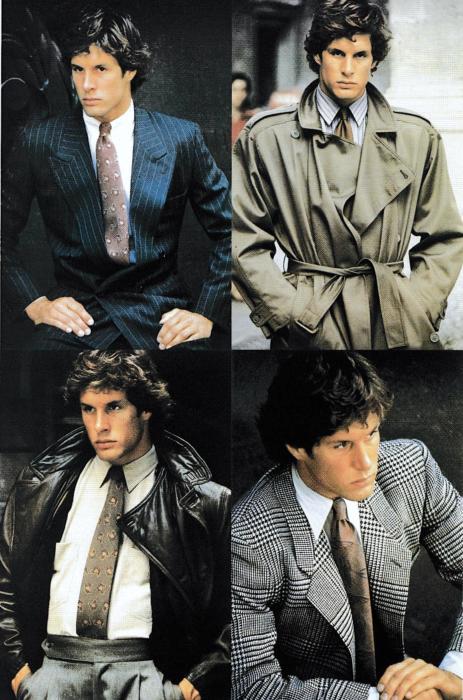
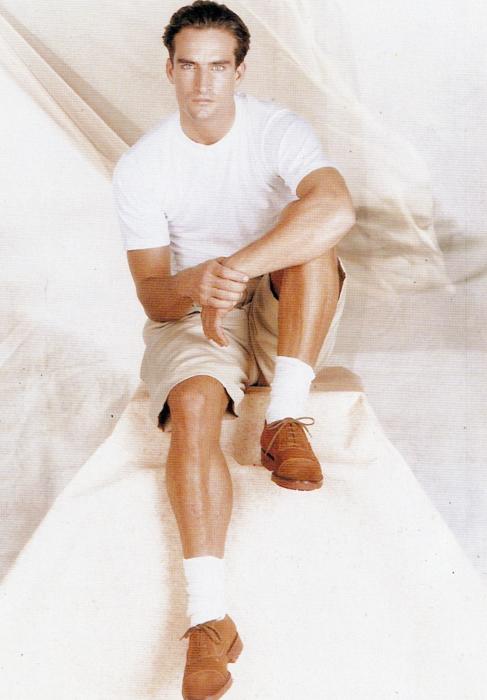


























Tony and Simon,
Let me ask the two of you: If I wanted a suit made for me in an 80s Armani style, how might I go about doing that? Armani’s own collections would likely have moved on since then. What tailor style would be closest: one from Armani’s native Milan, or English drape with its generous chest and extended shoulders?
Armani liked to make suits out of fabrics that were unusual for men’s tailoring. I’m thinking of wool crepe in particular. Do you know if this sort of fabric available in the bunches of any mills or merchants?
Thank you.
From what I know, the short answer is no one is going to give you an Armani style, because they’re not going to know the cut well enough.
But, if you want a roomier jacket, longer, extended shoulders, then I’d say an older school Neapolitan like Ciardi or Panico, as long as they’re happy to go roomier and longer than usual.
Crepe is used today occasionally. Michael Browne works with it. But to be honest it’s not a great feeling fabric. It’s very wrinkle resistant and has great stretch, but has none of the aspects I like about any other type of wool.
But then you might already have something in it and like it.
Zara copy Armani of that period . Obviously not as good .The cut is simple . Oversize jacket based on demob style suits . No padding and longish . That’s basically it . High waist trousers and two pleats very baggy . A good tailor could easily get the look
As regards fabric ld go for a sharkskin maybe from Huddersfield . Someone like English cloth . I’ve taken about ten lengths of it to ltaly where l live and had it made up . It would work well with the Armani look . My tailor could easily make you an Armani look suit and he’s one of those who would recognize the style
Go on eBay or Etsy and select your style and size. They are on there very inexpensively.
They are rarely on there
Hi Simon. Armani, My first suit proper in the mid eighties. Four buttoned, blue, double breasted worsted. Faint wide light blue stripe. Pleated trousers with a turn up. It was as comfortable as a cardigan. I can still picture it. I loved to wear it.
Must say it feels strange to have an article about 80’s Armani without a snapshot of Richard Gere arranging his clothes on the bed in American Gigolo! Correct me if I’m wrong but that was the film that catapulted Armani into popular culture?
Absolutely. We didn’t include it because those images are so well-known, where the ones from the collections over the years, in this book, are less so
His clothes are watered down Armani not the baggy style
As someone who has sold Armani (among other brands) for many years, I’ve always been in love with those slightly droopy shoulders you see on their jackets, blazers and coats. I bought a down-filled, rather long coat from them last season, and the shoulders make it a million times more elegant and refined than anything from Moncler or Canada Goose, despite being nearly as voluminous. It always bothered me when customers who had no eye for details told me that „Armani only charges you for the brand name“.
There is a distinction between Giorgio Armani and Armani Collezioni. I think Collezioni was a bit of brand exploitation. Giorgio Armani was art.
They do now . Rubbish coming out all the time
Today it does
One of the most comfortable of all the top designers. Wearing an armani jacket was like stepping into a shawl cardigan.
Hi Simon
i owned a copy of this book. It was excellent. I recon about 40% of everything in there would still be very wearable today. But I think Armani is a designer whose look is best worn in its entirety and doesn’t lend itself to mixing and matching with other designers or clothes from other eras. There was a “golden era” between the late 1980s and early/mid 1990s that still look fantastic and effortlessly casual (as some of the photographs above testify). The fabrics were always fabulous. Anything from the American Gigolo era looks a bit dated now. It does help though if you are 6ft 4in and built like a athlete. Personally, I was more of a Cerruti 1881 fan but lots of his clothes from the same era haven’t aged so well or are quite as iconic. An interesting article.
“…the most maligned decade of 20th Century menswear is the 1980s. … not seen quite the same re-evaluation as the luxuriously androgynous spirit of the 1970s”
I’m afraid a smell a straw-man argument. No doubt, among the more debased, ‘countercultural’ meeja types this might be true. Among most people with a smidge of taste and interest in menswear the 70s will forever remain detestable while the 80s marked a (possibly ephemeral) return of elegance and occasion.
Agree I was there – if you are of a certain age you can’t deny you wore ’70’s styles. The 80’s was far from ‘The brash arrogance of the Thatcher/Reagan years is ripe for parody and derision’ – I can only assume the author didn’t live through the ’80’s as an adult – perhaps you kinda have had to be there to appreciate the throwing off of the wet blanket of ’70’s Socialism.
BTW no mention of ‘Miami Vice’ style?
No, no mention of Miami Vice. Both because the clothes were a caricature of the style, and because this was specifically about the Armani collections over the period.
I respectfully disagree. As a teenager in the 1980’s, I started reading GQ around age 15, and the clothes that appeared each month (starting for me in May of 1987) were spellbinding: the rise of the new Italians (Armani, Versace, Gianfranco Ferrè…) and avant-garde Japanese designers (I recall especially Yamamoto, Comme Des Garçons and Matsuda), along with Jean-Paul Gaultier at his most polarizing and poetic… The imagination and palette for textures both physical and historical jumped off of pages featuring the immersive advertising of Ralph Lauren or the wit-infused traditionalism of Alan Flusser. But as I watched in my twenties, there was a considerable backlash at the hands of the new minimalism of Calvin Klein, the willful proliferation of the basic and beige care of the Gap and its extensions (a bought-out Banana Republic and Old Navy), and the rise of casual Friday culture… Grunge created commercial retreads of the spark of punk and Marc Jacobs brought grunge into high fashion. Not all of it was bad, but I missed the excitement, elegance and pointed self-possession of the 1980’s. So, yes, to my mind the backlash was very real… And to my didn’t really begin to fade until the Slimane-influenced skinny suit begin to look more and more like the mainstream. The seventies are having a moment (as are their twenty-year-cycle cousins, the 90’s), but as far as I’m concerned, the floodgates are back open. Maybe I’m just old and don’t care anymore? I’m just so glad pleats (and drape, and movement) are back…
I have one of Scott Fraser’s knits and it’s a favorite. The first thing you notice is the quality and attention to detail. That’s important. Plainly it’s meant to last a very long time.
The second is that while his style might seem slightly anachronistic, it’s never quite clear what period he’s drawing from. You just feel like it might be from some resonant, Hollywood infused, Anglo Italian mythic past. But then again, maybe not, because the designs are all highly relevant today. I like that.
The last thing I ever want to see is an old photo of myself in a getup that pins me like a beetle to the exact stylistic moment in which the photo was taken, and this becomes increasingly important to me as I find myself playing the back nine in life.
I think a more apt comparison would be more to Ralph Lauren, back in the days before he went mass market and corporate, than to Armani. RL famously created a vaguely aristocratic, Mid Atlantic, Anglo American style that existed in myth if not reality, which was also wearable and highly relevant to the time. The difference is that Scott Fraser’s inspirations are drawn from a very rich vein of source material that RL never touched. As to why, I might suppose it’s because this source material is more democratic than aristocratic, which to RL, would have been an anathema.
A lovely, thoughtful comment Carl, thank you
I had several pair of trousers with those unique pleats and I absolutely loved them. They were fantastically comfortable and I loved the way they looked.
If you’re referring to the classic Armani “scissor pleat”, yes sir! I too had several pair and loved the look and comfort as well. Every year when the Armani rep came for the trunk shoe I ordered at least one pair. The only reason I stopped buying the scissor pleat was because it was discontinued unfortunately.
Scott, Stephen – I’m too young to have owned originals but am very jealous that you both did – do you or any other reader know any menswear providers that do similar pleated trousers?
Go on eBay or Etsy and buy some originals!
I’ve always felt that one of the defining features of single-breasted Armani sportcoats and suit jackets was the dropped, wide-angle notch on his lapels. The angle was wider than any I’ve seen before his innovation, and they were also much farther down than any previously seen, at least within a couple of the decades prior to him. Can’t say I liked those notches or their placement, though. I much prefer a higher notch and one with less obtuse an angle. As an undergraduate maths major, I’ll argue it’s just better trigonometry!
Oh my! I had the Woodhouse (London retailer) version of the double breasted pinstripe in the early eighties. Back in the days when I had money, pre mortgage and children! It would have been 81 I think and I wanted to look like Richard Gere in American Gigolo. Sadly according to my then girlfriend now wife, the suit was the only similarity.
Wonderful article with stunning images.
I have an Armani trench coat, very similar to the one in this article, that I purchased in the 80’s. Wide shoulders, lots of fabric, long, of a beautiful color. I have hesitated to wear it 40 years later as it is distinctly of its time. Should I get it out – and what kind of hat would I wear?
I would Jack, it sounds lovely.
Hats are hard, and not quite part of the Armani aesthetic most of the time. I’d suggest just an umbrella, at least to start with
I was 17 when I first picked up the January 1990 issue of GQ and came across the “Armani Revolution” article that hooked me on his designs (though I confess to buying the issue for the Herb Ritts Cindy Crawford pictorial). I later picked up the Images of Man book and also the book from the Guggenheim exhibit in 2000, which I visited shortly before it closed. His 20th century collections were stunning in the use of fabrics, patterns, and colors–for both men and women–that feel timeless. The silhouettes will, of course, go in and out of fashion. Haven’t been a fan of his 21st century work so much, but his early stuff is so good that it earns him the ranking as one of the best designers ever. Search for the short film “Made in Milan” that Martin Scorcese shot in the late 80s that captures this time in Armani’s history so well.
Wonderful, thanks David
men’s fashion in the 70’s & 80’s ( with exception of Ralph Lauren) were an embarrassment.
what was the story of the gentleman asking the duke, “ Do you have any Armani suits?”
”Yes” was the reply. “All of our drivers wear them.”
I hope you don’t mind me saying, but it would be more interesting if you made a substantive point about the designs – what you actually don’t like and why
I believe I did with the quip.
Well, no not really. You just said they were an embarrassment and commented on who wore them.
It would perhaps have been more interesting to know what you thought was embarrassing, in terms of cut, cloth, colours etc. Quips are entertaining but usually less interesting
I think it is relevant insomuch as Armani’s ‘80s softer style was probably the most meaningful tailoring development to follow on from the structured look of the ‘70s pioneered by Tommy Nutter / YSL and their cohorts. We seem to be going through a similar evolution now with the trussed up Pitti Peacock look being superseded by more drape. I wore a lot of Armani back then. I liked the relaxed style, his colour palettes and the fact that he developed a total look with his shirts with their hidden button down collars, softer ties and the like. Armani himself was, of course, hugely influenced by the softer styles of the ‘30s and ‘40s
What I didn’t like about Armani was that it was not well made, a lot of his fabrics did not wear well and he undermined his own brand with reckless diffusion lines . It was these factors that drove me into the arms of Zegna and then on to bespoke. In terms of his relevance today, I think it’s worthy of note that although history repeats itself, it doesn’t repeat itself in exactly the same way and what is more healthy about today’s scene is its eclecticism and the variety of influences. That said, ‘The Drape’ is back. Just don’t go all ‘New Romantic ‘ with it. Leave that to those Pitti Peacocks.
Thanks David, great comment – informed and personal
In the US, Armani is significant because he arguably ended Ivy’s dominance of American tailored menswear. While the American established gentry largely stuck with Ivy, men who would once have outfitted themselves in Brooks Brothers upon joining the monied now turned to Armani and his imitators instead (taking more than a few scions of the gentry with them).
Comments like this are exactly why I love Permanent Style.
Many thanks for this wonderful flashback. I’ve always liked the Armani brand, probably more so for women than for men.
For men I always thought it was a brand for one body type only. It looked fantastic on the models and Richard Gere and no doubt on its core market, the American tall, athletic college “jock” or young professional – apologies for the cliché, but I do hope you can see its use here. They could fill the excess volume just nicely.
If one were tall and (very) slim, one looked like a clown. I found that out myself when I tried a suit in the Armani shop in London in the nineties. Ever since I’ve gone for the tailored look.
I’m very slim and a little on the short side. As much as I love drapey cuts I get lost in them. I look like a little boy dressing up in his Dad’s clothes.
I remember 70’s menswear, lots of polyester, loud patterns and colours. It was hideous. Armani and other designers in the 80″s made menswear elegant again.
This might be my favourite PS article! A testament to the power of our senses to whisk us instantly back in time…
In my case, to 1988, when I received my first student loan cheque (£500), and instead of doing anything remotely scholastic with it, I headed straight down to Brompton Road and bought myself an Emporio Armani suit. Aldo Fellai’s photos in magazines such as Arena were shamelessly used for promotional purposes for the University clubs I was involved with.
Until discovering PS and the world of bespoke tailoring a few years ago, Armani was always my go-to, and I still regard Signor Armani as a genius.
I now find myself drawn to the Ciardi-esque Neapolitan style and I don’t think I’m being too fanciful in feeling that although Armani is a Milanese brand, his style has always had the ‘unstructured’ influence of the Neapolitans.
So, for me, 1980’s Armani is extremely relevant!
Thank you Tony and Simon.
Thanks TOS, lovely to hear.
And yes you’re right, Armani’s location wasn’t that reflected in the tailoring. Lots of unstructured and to an extent southern Italian influence in there.
As some have already mentioned, when I think of Armani, I think of 80s excess and Richard Gere. Especially in the movie, “Pretty Woman.” I also think of Armani female clothing in movies, such as “Mannequin” with a young Kim Cattrall.
I am not a fan of the Armani look as many consider it, including me, a fashion mistake from the 80s with the huge shoulders and excess fabric. Also, it symbolizes the greediness and excess of the 80s which the fictional character Gordon Gekko would be proud of. But, I recognize it as a part of fashion history to be discussed and examined.
Thanks Dan.
I think one thing I’m a little disappointed in, is that some people can’t seem to see past those fairly simple associations of the clothing.
The point of any discussion like this, of a trend, is not whether you should copy it wholesale today or not. It’s the myriad of things the style included, from tonality to texture to line and fit, and be inspired by little parts of it.
That’s what Tony picked out in the article, and I would have been interested to hear what readers would pick out themselves, and perhaps work into their own clothing.
The way modern brands like Saman Amel or Stoffa use texture and, especially, tone-on-tone is arguably a legacy of Armani.
True, good point
It was the only really cool look of the 80s and it’s still cool becsuse very few could own one . I neatly bought one on email the other day for 50 quid . It was the real baggy Armani . But the reason why it was cool was that it was totally non office . I hate things that look like you’d wear them to the office . In my own business of making made to measure shirts in ltaly ld only do something office if a client wanted it .The great thing about Armani is that he took the 1945 demob suit and made it cool
One aspect of Armani is how good the clothes look in motion, when one is walking and moving about. Some outfits are designed to flow, others to flip and still others to float. Most clothes are designed to look good static but Armani is kinetic, dynamic.
Nice point Bryan. Some video footage in here would have been to show that.
I’m not sure to what extent it’s appropriate to call Armani or any menswear designer pioneering. How pioneering is it to take the popular proportions of the day and… make them bigger? This was my attitude when Thom Browne caught fire. How bereft of creativity is an artistic field when the most celebrated idea du jour is “make it smaller?”
These designers put a set of quite simple ideas out into the world and consumers liked it. Are they taste-chasers or taste-makers?
I don’t think that’s really fair about Armani Ben, though it may well be about Browne.
Armani didn’t just enlarge silhouettes, in the way no tailoring is that simple. It’s not just about making everything bigger, but reshaping and adjusting proportions, working out how much bigger to make a cuff compared to a bicep, a hem compared to a thigh. These kinds of decisions are the essence of cutting.
That’s a small point, though, compared to all the other ways he was innovative and influential. The unique stripping out of structure (it was done, in the South, before, but not in the same way), the unusual use of materials in menswear, weird use of pattern and texture, unusual use of colour/tonality. Then the style of the outfits and combinations, plus the way they were shot and presented. These were all things Tony picks out above.
Finally, this was at a time in the late 70s when there was still very little ready-to-wear fashion in Italy, especially for men. It wasn’t like today, when everything feels like a rehash of something from the past 50 years.
Can anyone offer guidance on how I’d be able to find a jacket similar to (if not the same) as the short “shearling blouson” at the top of the article? I’m aware this is a bit of a stretch, but it’s been calling out to me the past few days and after a few hours of digging I’ve yet to find anything similar. TIA to anyone who can offer help.
One option, Mario, would be to have a shearling jacket made and change the proportions to be more like this – at someone like Cromford for example. Or a sheepskin version from Chapal or similar.
Do bear in mind though, that while these proportions might look amazing in a single fashion image, they might look a little tired if worn all the time by a regular guy. Worth erring on the side of caution with how extreme you go.
Very interesting article and I am surprised by how stylistically appealing the images are. Not perhaps the dropped lapels or similar details but the overall texture and relaxed formality – that’s probably not actually a thing – which maybe the current dominant Italian tailoring evokes?
If you had asked me five / ten years ago, I wouldn’t expect to now be wearing pleats or wider lapels, but I am, and it just feels more natural and sophisticated as well as relaxed, without actually being casual clothing.
All therefore suited to our new normal as stated above.
To this teenager of the seventies who was fed a steady diet of Haspel suits the work of Armani was pioneering. GQ was all I had. And what I saw I liked. Every month. His clothes were everywhere. I didn’t have the historic framework of cynical industry folks, I just knew that putting on one of his blazers was like the sex I wasn’t having. Maybe the quality was lacking, but I can promise you the girl admiring the Armani clad man across the room had several things on her mind. And the absence of a floating canvas was not in the top three. Any American male of that era with an interest in clothing at some point peered into his bathroom mirror with his best pout convinced he could be on the other side of Fellai’s camera. Nobody walked away from a Brooks Brothers spread with such dreams. And yes, that was the marketing, but Fellai’s images could only carry Armani so far. The rest was up to the design and the design was beautiful. Almost half a century forward the styles seem dated, but that is simply unfair. If you can’t look at these clothes and sense the brilliance I challenge you to look again.
This is the most important piece I’ve seen on contemporary style to date. Mr. Sylverter has nicely examined and dissected the coming trend. As far as the tight little suits so remindful of children’s clothes, never has an idiotic style taken so long to die.
Thanks for this article – really good read, hope you don’t mind my 2p from an off-the-peg perspective. Personally, I think there is an interesting generational divide between opinions towards Armani and the cuts he is famous for. I’d use my father as an example, who bought a lovely charcoal double-breasted Armani suit, similar in cut to that in the cover picture, in the mid 80s in the Harrods sale (when heavy markdowns weren’t so rare) along with Dunhill and Feraud suits of the same ilk and wore these heavily for work (with multiple repairs) however would not be seen dead wearing any suit of a similar style today. Luckily these suits have survived in his wardrobe and I made the executive decision to nab them to wear (all but the Armani jacket fit me well), not that he’d be too bothered as they’ll always be his old 80’s suits.
Personally, I think that the looks created by Armani in that book, for all its drape and high rises, are sensational, and for me most of them transcend any particular connotations one might have of that era – maybe because I wasn’t alive then. However (and I may be biased because of my Dad’s attitudes towards the clothes at the time) I struggle to believe that consumers of the time would have been as awestruck as we are in 2021 at Aldo Fallai’s imagery. Whilst Armani created revolutionary tailoring which we can gawp at now, what strikes me equally is the likely ambivalence of its wearers in the 80’s. Even as an aspirational purchase, Armani was available in a period where high-end designer tailoring was more accessible and democratised – you could buy an Armani suit at a local high street menswear retailer, evidenced by their own labels also sewn in to the lining, or (as my Dad did) wait for decent sales to be able to afford it.
I think for 80’s Armani to be truly relevant today, the mainstream menswear market needs to be in a position where these styles are more widely adopted again, nudging tastes back enough towards fuller cuts and relaxed trouser lines for Fallai’s imagery to be seen less as a novelty and more as a progression of a norm. Brands today are still harking back to their old styles as something exclusively ‘80’s’ or ‘90’s’ – take Ralph Lauren releasing their ‘Big Oxford’ shirt as part of a small capsule run recently – I don’t think the confidence in the market to adopt this into any main line is there yet. I really hope Scott Fraser Simpson and other designers have every success bridging this gap, as I think tasteful ambivalence from the mainstream towards high rise, relaxation and drape needs to return again.
I would argue more relevant than the last couple years where clothing was so tight that a seam was in danger of bursting any moment.
History does repeat itself even if the general proportions represented in most pictures may not.
I would argue that the Armani style us rooted in the 1929s through 1930s.
In the late ’80s I was invited to try on a navy blue double breasted wool Armani suit at a shop way up the High Street in Winchester. I really couldnt afford it at the time and by the time I was spending that sort of money on suits I was shopping at Gieves and Hawkes in The Square. But I can still remember the wonderful fit of that suit. Straight off the hanger it just fitted me in a way no other suit ever has.
I have that raincoat and I had the jacket in the photo with the guy looking down. Easy to get excited.
Wonderful and rather moving article! Thank you.
Though I can’t now wear the tailoring I keep the jackets for sentiment, and still wear the collarless asymmetrical linen shirts.
The hefty book published to coincide with the Armani Guggenheim New York show in 2001 is a fine record of Armani grace and brilliance. And contains many of the best archive photos.(Guggenheim publications).
Ben Frankel,
Brilliant, thanks Ben. One more for the wishlist
I’m far from being a fashion historian, but it seems to me that Armani was inspired by Hollywood of the late 1940’s–think Gary Cooper and Cary Grant of the period. Armani, born in 1934, would have been an impressionable teen at the time, and in post-war, small-town Italy, just imagine how glamorous these actors would have seemed, how luxurious their suits would have looked. Armani’s inventions were therefore a revival of sorts. It was his use of soft, drapey fabrics–fabrics hitherto thought to be only womenswear fabrics–that was the great innovation. But while I like Armani’s wide, sloping shoulders, I’m not fond of his voluminous cut. Cooper and Grant circa late 30’s–with nipped-in waists–look ideal to me, and I’ve managed an approximation of the style by having my tailor alter the body of a couple of 80’s Armani jackets I’ve found, while keeping the shoulders. He’s a master artisan, and these are now some of my favorite jackets.
By the way, the Armani museum in Milan, Armani/Silos, is pretty damn perfect in every way: architecture, decor, display and the collection. The clothes look absolutely wonderful, with more variety and invention than I had ever imagined. The man is brilliant.
Hey Tom,
Great recommendation on the museum, that is wonderful.
Armani was certainly influenced by actors of that period, and the clothes in general, but as you point out the cuts were still different and the materials, textures and use of tonality and clashing patterns were all very different.
Dear Simon,
Nazim from Paris, thanks for your brilliant article about Mr Armani vision of Style. I really appreciate it. Especially coming from someone who promote the sartorial work. I’ve been working for more then 20 years for GA. I agree with u his best contribution is from 70’s up the 90’s. Currently, I would prefer south Italian Tailoring, such Ciardi in Napoli and Crimi in Palermo, u should have a look at their excellent work. Of course sartorial-niche- brand, from Uk, Italy and Japan. Finally, I really enjoy the content of your bespoke style release. Thanks for your kind dedication.
best regards.
Nazim.
Cheers Nazim, that’s great to hear. Yes I’d love to go check out Palermo one day
Hi Simon,
I really enjoyed this article. The relevance of 80s Armani is an interesting question.
I first saw an Armani suit in the window of a shop in Brighton in 1989. It was stone grey, double-breasted and stood out a mile from the other items displayed because of the subtle colour tonality and the drape of the fabric. Armani had me hooked there and then. I had a dalliance with Hugo Boss suits for work but there was no comparison with Armani in terms of cut, fabric and brand mystique. I also loved how the shirts and ties in each collection were designed to tone with the suit and jacket fabrics. I agree with one of the other posts here that Armani works best together and not mixed with other brands.I still have most of the Armani even though I am semi-retired.
In the early 90s I started to buy some Hilton suits since they were made by Vestimenta who also produced the Armani black label clothing. Vestimenta essentially copied the Armani style but were less expensive.
What strikes me is that the generous proportions of Armani’s 80s/90s tailoring is clearly not on trend these days but the lightness of the clothes, fabric, colour tonality and ease of movement still resonates. I have no interest in trend led fashion, never had, but Armani spoke to me in a way other brands didn’t because the clothes were eminently wearable and I continue to buy from the current collections.
Hi Simon,
Congratulations for this article, it’sgreat to see Armani getting more attention on PS which, in my view, is in keeping with someone I regard as one of the great designers and influencers of menswear.
One comment in the article that especially resonated with me was, “Sometimes you just have to look back to look ahead.”
I am perhaps older than many PS readers and can remember the early Armani collections in Browns (also Aquascutum), C.1977, I first bought Armani in 1978. Until the end of the 80’s he was my go-to designer for “tailoring.”
Initially, his tailoring was like nothing most of us had ever seen. This extended to the colour palette, taupe / greige, texture of the fabrics, aside from the actual designs themselves. Much is made of the lightness / unstructured nature of the tailoring, which wasn’t as new as it was suggested. What Armani added to this was fluidity, the clothes had a drape to them which made them wonderful to wear.
I have been planning to revisit his ideas in my own wardrobe for the last 12-months. I worked from home pre-Covid and have always struggled with what to wear trouser wise. Jeans have never suited me, and the heavy denim take so long to soften-up. Equally, flat-front trousers tend not to be elegant / flattering on me.
Having seen virtually all the Armani collections, in my opinion his work between 1982-87 was the high point. It was during this period that the ideas all came together, after that it was variations on a theme. Having tried on some of my olds suits, the jackets do look hopelessly “of a time”, but the trousers, I feel, are still relevant. The key was that they were “round legged”, the effect created by the pleat, which is basically a box-pleat. Pictures 3 and 8above, show the pleat and how he sometimes “reversed it”.
Earlier this year I spent some time trying to explain this to Luxire, but they had never seen anything like it. Added to this, I probably explained myself badly. When revisiting this with them a few weeks ago, we had a breakthrough when I explained that it was box pleat, no different to what they put on shirts. At this point it was “yes”, we can do this, however, I still think they were wondering why anyone would want to!
The next step was dimensions, I usually wear trousers with forward facing pleats, but these needed to be looser to create a drape. I guessed and added 1” from the hips down, the leg opening was to be 8 1/4”, which mistakenly they made as 9 ¼”. On first inspection this looked wide but trying them on it works. Also, the length, they need to have a real break on the shoe.
The fabric I chose was Solbiati, stone grey linen, and I have just ordered another in indigo wool/silk/linen from VBC.
For winter I will probably use cavalry twill
In terms of styling outfits around the trousers there is a need to use the “right” fabrics and follow through of the softness and fluidity which Armani offered.
The article makes this point well, e.g.
• Texture is used to create contrast. A donegal tweed jacket paired with a surprisingly robust-looking shepherd’s-check shirt creates unexpected harmony between the pattern sizes.
• The heavy stripe of an overcoat lies over the deep diagonal line of a cavalry-twill trouser.
• A chunky polo plays off the marl of a covert-cloth sports coat, the whole look rich and tactile, despite being shot in monochrome.
• Prince-of-Wales checks are exploded into oversized detail, and sports coats use jacquard-like weaves rather than more commonplace windowpanes.
Fabrics such as cavalry twill, tweed, herringbone, hopsack, linen all have the requisite texture.
In terms of what I plan it’s as follows:
Jackets, as I wrote above, the jackets are “of a time” because of the proportions but the softness and fluidity required can be found in Belvest’s Jacket in the Box range.
Coats, they need to be long rather than just “big”. Raglan style would be my preference, I don’t like myself in belted coats
Knitwear, as the article says, “chunky polo”, but even finer, closer fitting knits will work and balance out the proportions created by the trousers
Shirts tended to be striped more than plain. I will repeat what I did years ago, mixing checked jackets, with striped shirts, and patterned (likely, paisley, or madder)
My intent is to create a parallel wardrobe, different in some ways to what many are currently wearing. Why? Everyone needs a change, it’s good to be different, and as you get older you become nostalgic……….
Philip.
Wonderful thoughts, memories and detail, thank you Philip.
Tailors sometimes call that a ‘kissing pleat’ by the way – see Cerrato’s trousers here at the bottom of the article
Philip, fantastic post and I would dearly love to see some of the results. Instagram?!
I have an account there, Paul, but I have never posted anything. Perhaps it’s time i did!
Hi,
Firstly, apologies for the delay in responding, the thought of putting pictures of myself on the internet, albeit Instagram, just seemed a bit pretentious! However, having got over that I have, this morning, posted three. You will not need to be an expert to guess this was the first time!
The other reason for the delay, refers to how I planned to style the trousers with existing parts of my wardrobe. I still feel the Belvest jackets can work, but finding the “right” coat proved difficult, they tended to be too sartorial in style, even a “Balmacaan” style lacked the proportions.
As my wife pointed out, “if you are going to do this, do it properly, source the actual clothing”. A quick trawl through eBay showed numerous possibilities, however restricting it to “Black Label” only narrowed the field considerably.
In the last 3-weeks I have sourced three jackets (one is in the Instagram post), and 2 overcoats. If there is interest in the pictures posted I will show the new arrivals as and when I wear them.
It was interesting comparing the black label jacket to the Belvest, stylistically, the lapel gorge is lower, the jacket is ventless, and longer in length. The shoulders, whilst several inches wider than the Belvest’s natural shoulder, aren’t US footballer width. I feel that the proportions work better with the looser, round legged shape of the trouser.
I see this as a parallel wardrobe to what I would call my “sartorial” clothes. It is neither better nor worse, it’s different. Where I do see advantages are in wearing knitwear (long or short sleeved), as it is less “formal”.
I have long disliked the term smart casual, regarding it as a pointless oxymoron. Simon has made the point previously that readers want to be “well dressed”, which I agree with. To sum that up in one word the term elegant might be used; I see my parallel Armani inspired wardrobe as relaxed elegance. Even if the pics are anything but!
Philip
Arrogance? Parody? Derision?
As it relates to Thatcher/Reagan years?
Please do expound sir.
I really enjoyed this article and will look out for the book… One activity that has come to mean more to me now that so much of what we see is online is looking at a beautiful book of beautiful photographs of beautiful clothing. Perhaps it means even more now that we have fewer occasions to dress up. I wanted to also mention that other movies besides American Gigolo showcase Armani’s designs. His clothing added to the stylized aura of the (otherwise kind of thin) 1992 Paul Schrader film Light Sleeper, but the real guilty pleasure is his work for Brian De Palma’s 1987 adaptation of The Untouchables… He has been given a wonderfully free hand with both the heroes’ earthy sobriety and the gaudy excesses of Capone’s mobsters. It’s worth watching for Andy Garcia’s suede blouson jacket, Sean Connery stumping around in tweeds and a cardigan, Kevin Costner in an earnest charcoal 3-piece and Billy Drago (as mob trigger man Frank Nitti in a fantastically arch cream-coloured DB + fedora ensemble complete with spectator shoes. Excessive but (unless you lived through prohibition) nothing you’ll find personally regrettable.
Great call, those wardrobes are wonderful
There was never anything as exciting in menswear before or after 1980’s Armani.
early 80s. big time adv agency in ny. t was easy to see the top of the top–paul stuart, brooks, etc. when i had saved (and saved) and timed the barneys sale (pre- warehouse) i bought a grey nailhead single breasted inverted single pleat suit. the first year of black label. it was a SPECTACULAR change from status quo. received comments from all quarters–some denigrating, some adoring–ALL seeing a revolutionary difference. in 1981 the suit was reduced by 50% to $450us. (in 1981 $900us was ALOT) it was a super hight quality (mfd by hilton), super, but just inside the line of acceptable business, style at a glance. i will never forget it. in fact although my son wore it through his early teens and ive since grown several sizes up its still in my closet. love taking a look every time and again.
question is: anything these days that has that kind of punch or impact? is there anything that signals the high water mark of quality and style. anything at all??
jeff
I modeled back in the mid-eighties and got to wear the best stuff-and the worst stuff.
Giorgio Armani style peaked in the mid eighties. The collections of 1985 were an inspiration. That superhero proportioned pinched waist jacket was running $375 and was unique blend of gold, olive and black fibers that gave it a vaguely militaristic look. The coat collar was incredible. No one has done collars as good as Giorgio Armani did for 1985. The coat even had a strap to cinch the waist in the jacket further and then hang down the side below the waist in the back. Swagger.
The matching thick fabric pants when worn with the jacket and a white shirt and Giorgio Armani tie looked absolutely incredible. Being 6’2″ Giorgio Armani was the best draping designer of the period and it all looked fantastic when worn, whether it be a suit, a wool coat or the super cool “super hero” jacket.
His use of “warm monochromaticism” gave all his clothes a sense of subdued understatement. The rich, heavy well-draping fabrics spoke for themselves and didn’t need brash colors to speak for them. His designs stood out for this rich minimalism. 1984-1988 was a color explosion. Calvin Klein, Ralph Lauren, Hugo Boss, Bennetton and so many more were mixing purples with blues and the most vibrant colors and while these designs were indeed brash, many had their own charm. Some designers already recognized the Giorgio Armani appeal and had offerings that were also more ascetic. However, none could match the vibe of Armani.
This era will never come again. The quality of “Giorgio Armani” branded wear was light years above what was being sold just 5-10 years later at the Emporio Armani stores. And now the comparison with modern clothes would be like comparing a redwood with a ragweed. Armani clothing was the victim of its own success – as so many high end clothing designers (and products) are.
Shopping online, the death of the finest department stores and many menswear specialty shops has cast a pallor over clothing design and acquisition. Sure I still have the jacket and wear it on occasion. It still is in mint condition-as it was when new. And yes, there is a “super hero” quality to it. The inflated shoulders and sleeves were so bold a design, they intimidated some people.
I think the most amusing statement it garnered, made by a young woman back in the day, “It’s the epitome of obnoxiousness.”
I long for the days of “obnoxious” ready-to-wear Giorgio Armani clothing.
Nice article. Thanks for a trip down memory lane.
Lot of it was demob style suiting and the material was ordinary for the price . That said nearly everything is copied .
Armani basically copied stuff and amplified it . Not just with his baggy suits but also did punk which completely did me in because it was crazy . That said everything is copied
Punk ? Yes ld just come back from the uk and the Armani shop in montenapoleone was full of bondage stuff . Looked very strange . Another thing about Armani is that he got big with American gigolo and Miami Vice
When I saw the recent Fear of God, the eternal collection by Jerry Lorenzo, it took me back to this era of Armani. Both proportion and color palette as well as styling details. I will always have an appreciation for this way of dressing and can see Mr Armani’s influence in other current brands. The fact that unconstructed garments are even available in today’s brands show how menswear in that aspect will be forever in Armani’s debt.
My tailor could make one just by looking at it . That said it wouldn’t be exactly the same . The material on Armani from what lve had in my hands isn’t top level but it’s nice
Never really liked Armani and his claim to fame was essentially misappropriated from the Neapolitans (Vincenzo Attolini) and the likes of Frederick Scholte of A&S. The suits and sportcoats have always been way overpriced. His genius though was to leverage celebrity for pushing his products. At one point it appeared all of Hollywood was dressed by him. Thankfully, people have rediscovered the beauty and craftsmanship of handmade and bespoke garments.
I don’t think that’s really accurate, Tim. Agree that many people didn’t look great in his suits, and that handmade ones are better in many ways, but his originality in cut and colour and texture was a long way from Attolini or Scholte. Try and 80s suit from him and there’s really little in common with those makers